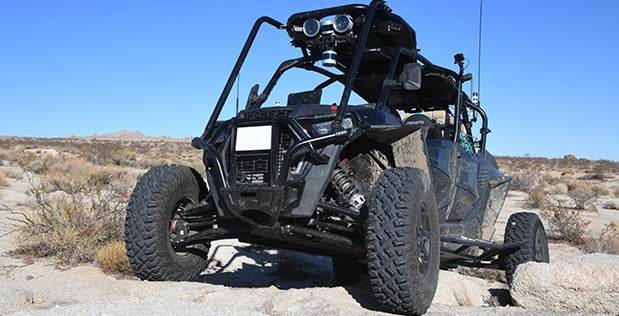
The Defense Advanced Research Projects Agency (DARPA) has successfully carried out the first deployment of wholly uncrewed and uninhabited fleet vehicles from the Robotic Autonomy in Complex Environments with Resiliency (RACER) programme in off-road environments.
Announced on 11 April 2023, this round of testing concludes the first phase of the RACER project.
The RACER programme has been developed with the aim of equipping uncrewed combat vehicles with off-road autonomy technologies that can enable them to match human-driven speeds in realistic situations.
Between 12 and 27 March, the programme showcased the ability of combat-scale vehicles to move autonomously in off-road environments that are more complex and unpredictable than on-road conditions. While the vehicle did not carry any passengers, a safety operator oversaw operations from a supporting chase vehicle.
In the latest experiment, teams have successfully completed more than 55 driverless runs, covering distances ranging from approximately four to 11 miles. The vehicles reached speeds of up to 25mph.
According to RACER programme manager Stuart Young, the experiment yielded noteworthy results. The team was able to enhance their off-road speeds while minimising any interaction with the vehicle during test runs.
RACER Fleet Vehicle guzzles sensor data
The RACER fleet vehicle (RFV) robots are equipped with a wide range of sensing capabilities, including a 360° range and image sensing. These include multiple LIDARs, stereo camera pairs, colour and infrared imaging cameras, radar, event sensors, and inertial measurement sensing.
The RACER high-speed, off-road terrain expected in DARPA’s tests demands a specialised electronics box (E-Box) that is environmentally protected, shock and vibration proof, and thermally managed. Computation tools equipped with multiple best-of-class graphical processing units (GPUs) have been engineered to meet these demands.
The combination of sensing technologies and a specialised E-box enables the collection of 4TB of sensor data per hour. This data is crucial in supporting artificial intelligence and machine learning-based autonomy algorithms, as well as stack approaches that are necessary for executing fast-paced combat manoeuvres in complex terrain.
Each RFV comes equipped with modifications for roll protection, sensor/E-box integration, autonomous control, and an increased power output of 7kW. Carnegie Robotics LLC (CRL) has successfully integrated the RFVs onto a Polaris RZR S4 1000 Turbo base drive-by-wire platform.
Transitioning RACER capabilities to the services
Representatives from the US Army and Marine Corps were present at the experiment to aid in the transfer of technologies developed in RACER to future service uncrewed initiatives and concepts.
Researchers from the Army Research Laboratory demonstrated the flexibility of the team’s autonomy software, an asset critical to transitioning RACER capabilities to the services.
The US Army’s National Training Center (NTC) in Ft Irwin, California, hosted a series of rigorous courses set in the challenging terrain of the Mojave Desert. Courses presented a variety of obstacles, including rocks, bushes, ditches, and trees, which could impede vehicle speed and even render them inoperable if not navigated with care.
The success of the mission depended on the teams’ ability to accurately perceive the terrain, strategise their paths, and expertly control their robotic vehicles at high speeds.
Returning teams from Carnegie Mellon University, Nasa’s Jet Propulsion Laboratory, and the University of Washington were also among the groups that tested the autonomy software. The participants successfully completed a challenging course using a fleet of 12 RFVs, covering a total distance of 246 miles over the course of 24.6 hours.
The teams were equipped with RFVs that had standard performance, sensing, and computing capabilities. Young commented that when the autonomy software is assessed in comparable settings, a direct comparison can be drawn with the performance of an experienced human operator.
Young adds: “During this latest experiment, we continued to push vehicle limits in perceiving the environments to greater distances, enabling a further increase in speeds and better adaptation to newly encountered environmental conditions that will continue into RACER’s next phase.”
Experiments escalating in difficulty
The experiment conducted this month builds upon previous tests carried out in March 2022 and September 2022 at the NTC and Camp Roberts, California, respectively. During the events, participating teams tested their autonomous software stacks, which were developed for the RACER programme, using robot systems provided by DARPA. The tests were conducted in various environments, following development runs that took place in different locations across the US.
In the first experiment, the vehicles underwent more than 40 autonomous runs of two miles each on six courses of a desert environment. With speeds of up to 20mph, the uncrewed vehicles demonstrated their ability to track, classify and avoid obstacles in rocky and bushy environments at high speeds.
Teams involved in the second field experiment faced more challenges that included steeper hills and slippery surfaces. Greater focus was put on testing the robot systems’ ability to maintain control while navigating long-range courses.
During phase two, the emphasis will be on refining software stacks and conducting tests to assess the level of autonomy achieved over extended off-road routes with minimal interventions. The teams involved in the project will transfer their autonomous solutions onto demonstration platforms that simulate combat-scale vehicles. In addition, it has been mandated that they double their speeds from the initial phase’s performance metrics.



